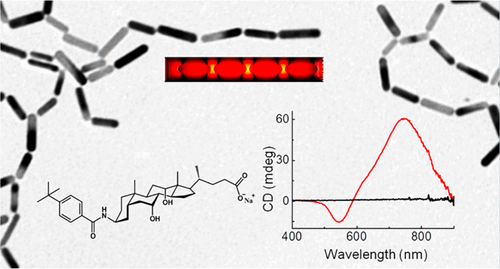Our official English website, www.x-mol.net, welcomes your feedback! (Note: you will need to create a separate account there.)
Plasmon-Enhanced Optical Chirality through Hotspot Formation in Surfactant-Directed Self-Assembly of Gold Nanorods
ACS Nano ( IF 17.1 ) Pub Date : 2020-11-24 , DOI: 10.1021/acsnano.0c03997 Emilia Severoni 1 , Sonia Maniappan 2 , Luis M. Liz-Marzán 3, 4, 5 , Jatish Kumar 2 , F. Javier García de Abajo 6, 7 , Luciano Galantini 1
ACS Nano ( IF 17.1 ) Pub Date : 2020-11-24 , DOI: 10.1021/acsnano.0c03997 Emilia Severoni 1 , Sonia Maniappan 2 , Luis M. Liz-Marzán 3, 4, 5 , Jatish Kumar 2 , F. Javier García de Abajo 6, 7 , Luciano Galantini 1
Affiliation

|
Plasmonically enhanced optical dichroism has attracted substantial interest for its application in optical sensing, where the interplay between chirality emanating from both molecules and plasmon-supporting structures has been regarded as a critical ingredient. Here, we experimentally demonstrate that suitably self-assembled achiral plasmonic nanostructures produce a high degree of enhancement in the optical dichroism observed from chiral molecules placed in their vicinity. Specifically, we identify a near-field enhancement associated with plasmonic hotpots as the mechanism enabling our observation of visible-NIR circular dichroism emanating from small amounts of chiral molecules. Our structures consist of linear arrays of gold nanorods obtained by introducing chiral anionic surfactants, such as modified bile salts, which lead to selective destabilization of a cetyltrimethylammonium bromide coating layer on Au nanorods, thereby promoting a tip-to-tip oriented assembly. The proposed mechanism of plasmonically-enhanced circular dichroism is supported by deriving a simple, yet general theoretical formalism that confirms the observed results, revealing the role of optical hotspots at the gaps of linear tip-to-tip nanorod assemblies as the origin of enhancement in the dichroism from chiral molecules. Importantly, it is the refractive rather than the absorption-mediated chiral response of the molecules that produces dichroism in the visible-NIR plasmonic regime, far from their UV absorption resonances. The observed self-assembly mechanism suggests that chiral analytes not directly interacting with the nanorod surfaces, but just able to induce tip-to-tip aggregation, can be revealed by a CD signature in the plasmonic region, thereby supporting potential applications in ultrasensitive analysis.
中文翻译:

表面活性剂指导的金纳米棒自组装中通过热点形成的等离子体增强手性。
等离子体增强的光学二向色性已将其广泛应用于光学传感领域,在该领域中,从分子发出的手性与支持等离子体的结构之间的相互作用被认为是至关重要的成分。在这里,我们实验证明,适当地自组装的非手性等离子体纳米结构会从放置在其附近的手性分子产生高度的光学二向色性。具体来说,我们确定了与等离激元热点相关的近场增强机制,使我们能够观察到少量手性分子发出的可见-NIR圆二色性。我们的结构由金纳米棒的线性阵列组成,这些金纳米棒是通过引入手性阴离子表面活性剂(如改性胆汁盐,这导致在Au纳米棒上的十六烷基三甲基溴化铵涂层的选择性失稳,从而促进了尖端到尖端的组装。通过推导简单而通用的理论形式主义,证实了所观察到的结果,支持了等离子体增强的圆二色性的机理,揭示了光学热点在线性尖端对尖端纳米棒组件间隙处的作用,是增强纳米结构的起源。手性分子的二色性。重要的是,分子的折射而不是吸收介导的手性反应会在可见光-NIR等离子体状态下产生二向色性,而不是其紫外线吸收共振。观察到的自组装机制表明手性分析物不会直接与纳米棒表面相互作用,
更新日期:2020-12-22
中文翻译:

表面活性剂指导的金纳米棒自组装中通过热点形成的等离子体增强手性。
等离子体增强的光学二向色性已将其广泛应用于光学传感领域,在该领域中,从分子发出的手性与支持等离子体的结构之间的相互作用被认为是至关重要的成分。在这里,我们实验证明,适当地自组装的非手性等离子体纳米结构会从放置在其附近的手性分子产生高度的光学二向色性。具体来说,我们确定了与等离激元热点相关的近场增强机制,使我们能够观察到少量手性分子发出的可见-NIR圆二色性。我们的结构由金纳米棒的线性阵列组成,这些金纳米棒是通过引入手性阴离子表面活性剂(如改性胆汁盐,这导致在Au纳米棒上的十六烷基三甲基溴化铵涂层的选择性失稳,从而促进了尖端到尖端的组装。通过推导简单而通用的理论形式主义,证实了所观察到的结果,支持了等离子体增强的圆二色性的机理,揭示了光学热点在线性尖端对尖端纳米棒组件间隙处的作用,是增强纳米结构的起源。手性分子的二色性。重要的是,分子的折射而不是吸收介导的手性反应会在可见光-NIR等离子体状态下产生二向色性,而不是其紫外线吸收共振。观察到的自组装机制表明手性分析物不会直接与纳米棒表面相互作用,



























 京公网安备 11010802027423号
京公网安备 11010802027423号